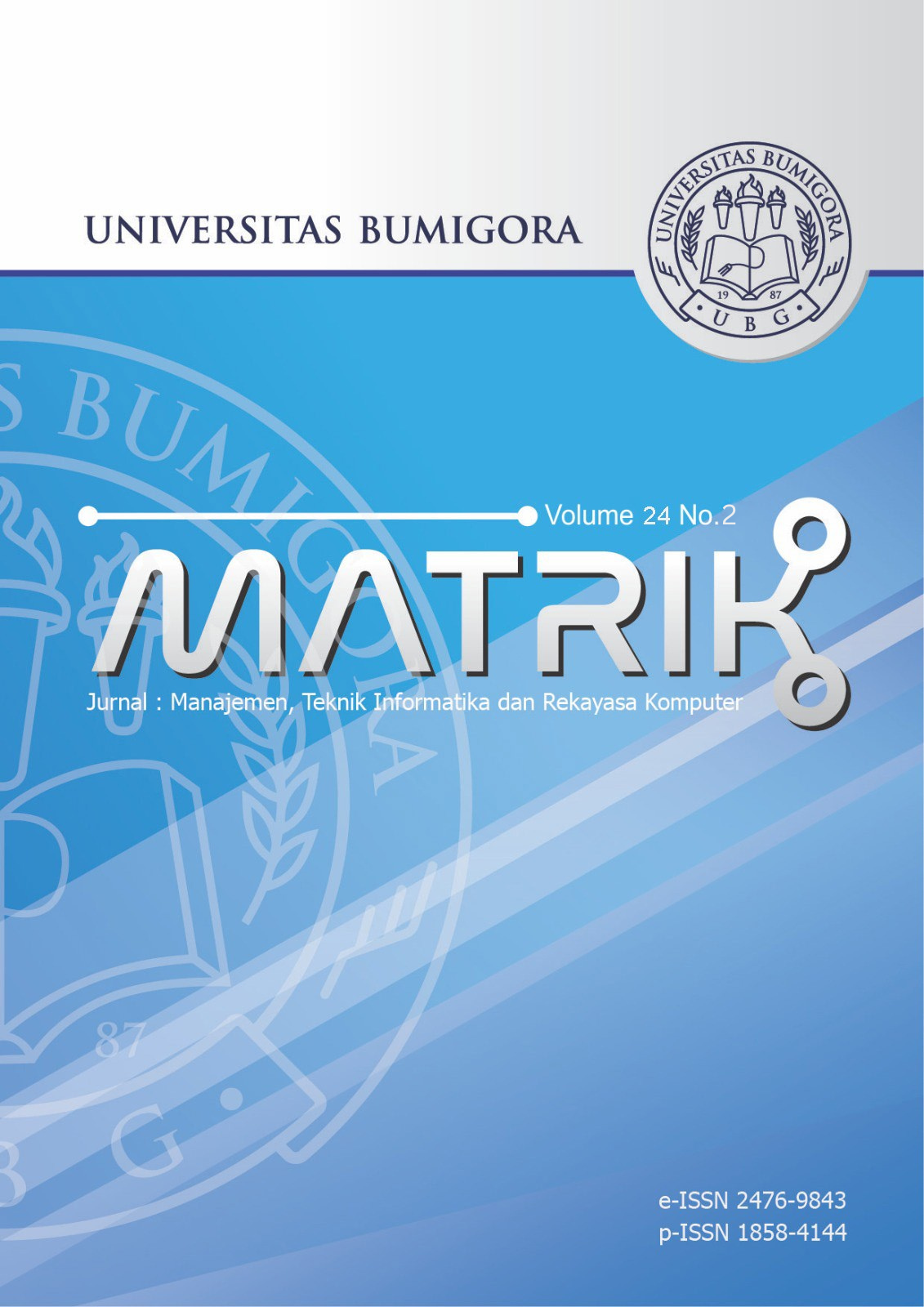Sentiment Study of ChatGPT on Twitter Data with Hybrid K-Means and LSTM
Analisis Sentimen Berdasarkan Hasil Klasterisasi K-Means pada Data Pengguna ChatGPT Menggunakan LSTM
DOI:
https://doi.org/10.30812/matrik.v24i2.4791Keywords:
Chat-Gpt, K-Means, Long Short-Term Memory, Sentiment Analysis, TF-IDF, Word2VecAbstract
The rapid evolution of artificial intelligence (AI) has transformed the way people interact with technology, with ChatGPT emerging as a standout innovation in natural language processing (NLP). While it offers immense benefits, such as improving productivity and accessibility, it has also sparked debates about trust, transparency, and user experience. This makes understanding public sentiment about ChatGPT both timely and essential.This study explores user sentiments by combining K-Means clustering and Long Short-Term Memory (LSTM) models for analysis. The research utilized a dataset from Kaggle, which underwent extensive preprocessing, including text cleaning, tokenization, and lemmatization. Key features were extracted using TF-IDF and Word2Vec techniques, while clustering was refined with the Elbow Method and Silhouette Score. The data was grouped into three clusters focusing on ChatGPT’s functions, its developers, and user activities. Sentiment analysis using LSTM achieved an impressive accuracy of 98% after five training cycles. The findings highlight that negative sentiments, particularly around technical challenges and transparency, dominate user feedback, signaling areas for improvement. While positive sentiments exist, they remain overshadowed by critical perspectives. This study underscores the importance of enhancing user trust and experience while ensuring ethical and transparent AI development. The insights provided aim to guide developers and policymakers in creating AI technologies that are more user-focused and socially responsible. Future research should include multilingual and cross-platform data to paint a more comprehensive picture.
Downloads
References
[2] F. M. Sinaga, S. J. Pipin, S. Winardi, K. M. Tarigan, and A. P. Brahmana, “Analyzing Sentiment with Self-Organizing Map and Long Short-Term Memory Algorithms,†Matrik: Jurnal Manajemen, Teknik Informatika dan Rekayasa Komputer, vol. 23, no. 1, 2024. DOI: 10.30812/matrik.v23i1.3332.
[3] Y. Akbar and T. Sugiharto, “Analisis Sentimen Pengguna Twitter di Indonesia Terhadap ChatGPT Menggunakan Algoritma C4.5 dan Naïve Bayes,†Jurnal Sains dan Teknologi, vol. 5, no. 1, pp. 115–122, 2023. DOI: 10.55338/saintek.v4i3.1368.
[4] D. Setiawan, D. Arsa, L. E. Fitri, and F. F. P. Zahardy, “Comparative Analysis of Clustering Approaches in Assessing ChatGPT User Behavior,†Cogito: Jurnal Penelitian dan Pengabdian Masyarakat, vol. 10, no. 2, pp. 366–379, 2024. DOI: 10.31154/cogito.v10i2.661.366-379.
[5] P. Yani and H. Baturohmah, “Analisis Sentimen Terhadap ChatGPT Plus Menggunakan Naïve Bayes di Twitter,†Sismatik: Jurnal Sistem Informasi dan Teknik Informatika, 2024. [Online]. Available: https://sismatik.nusaputra.ac.id/index.php/sismatik/article/view/210.
[6] I. Kurniasari, A. A. Alfin, and E. Widodo, “Implementasi Long Short-Term Memory (LSTM) dan Word Embedding Model pada Analisis Sentimen Layanan Uang Elektronik Ovo dan Link Aja,†Informasi: Jurnal Informatika dan Sistem Informasi, vol. 15, no. 2, 2023. DOI: 10.37424/informasi.v15i2.273.
[7] I. Dergaa, K. Chamari, P. Zmijewski, and H. B. Saad, “From human writing to artificial intelligence generated text: examining the prospects and potential threats of ChatGPT in academic writing,†Biology of Sport, 2023. DOI: 10.5114/biolsport.2023.125623.
[8] A. Nurkholis, D. Alita, and A. Munandar, “Comparison of Kernel Support Vector Machine Multi-Class in PPKM Sentiment Analysis on Twitter,†Jurnal RESTI (Rekayasa Sistem dan Teknologi Informasi), vol. 6, no. 2, pp. 227–233, 2022. DOI: 10.29207/resti.v6i2.3906.
[9] K. Maharana, S. Mondal, and B. Nemade, “A review: Data pre-processing and data augmentation techniques,†Global Transitions Proceedings, 2022. DOI: 10.1016/j.gltp.2022.04.020.
[10] R. R. Salam, M. F. Jamil, Y. Ibrahim, R. Rahmaddeni, S. Soni, and H. Herianto, “Sentiment Analysis of Cash Direct Assistance Distribution for Fuel Oil Using Support Vector Machine,†Jurnal Malcom, vol. 3, no. 1, 2023. DOI: 10.57152/malcom.v3i1.590.
[11] R. Sulthana, J. A. K., H. Harikrishnan, and V. Varadarajan, “Sentiment Analysis on Movie Reviews Dataset Using Support Vector Machines and Ensemble Learning,†International Journal of Information Technology and Web Engineering, vol. 17, no. 1, 2023. DOI: 10.4018/IJITWE.311428.
[12] F. Muftie, K. M. Yafi, and Q. M. Addina, “Perbandingan Performa Deteksi Cyberbullying dengan Transformer, Deep Learning, dan Machine Learning,†Jurnal Pendidikan Informatika dan Sains, vol. 13, no. 1, pp. 75–87, 2024. DOI: 10.31571/saintek.v13i1.4002.
[13] A. Sanmorino, Suryati, R. Gustrianysah, S. Puspasari, and N. Ariati, “Feature Extraction vs Fine-tuning for Cyber Intrusion
Detection Model,†Jurnal INFOTEL, vol. 16, no. 2, pp. 302–315, 2024. DOI: 10.20895/infotel.v16i2.996.
[14] A. Nurdin, B. A. S. Aji, A. Bustamin, and Z. Abidin, “Perbandingan Kinerja Word Embedding Word2Vec, GloVe, dan FastText pada Klasifikasi Teks,†Jurnal TEKNOKOMPAK, vol. 14, no. 2, pp. 74–79, 2020. DOI: 10.33365/jtk.v14i2.732.
[15] E. T. Wijaya, “Perancangan Information Retrieval (IR) Berbasis Term Frequency-Inverse Document Frequency (TF-IDF) untuk Peringkasan Teks Tugas Khusus Berbahasa Indonesia,†Jurnal Ilmiah Teknologi dan Informasi ASIA, vol. 7, no. 1, 2013. [Online]. Available: https://jurnal.stmikasia.ac.id/index.php/jitika/article/view/78.
[16] M. Guntara and N. Lutfi, “Cacah Klaster pada Klasterisasi dengan Algoritma K-Means Menggunakan Silhouette Coeficient
dan Elbow Method,†JuTI: Jurnal Teknologi Informasi, vol. 2, no. 1, Aug. 2023. DOI: 10.26798/juti.v2i1.944.
[17] A. T. Rahman, Wiranto, and R. Anggrainingsih, “Coal Trade Data Clusterung Using K-Means (Case Study PT. Global Bangkit Utama),†ITSMART: Jurnal Ilmiah Teknologi dan Informasi, vol. 6, no. 1, Jun. 2017. DOI: 10.20961/itsmart.v6i1.11296.
[18] M. Anggara, H. Sujiani, and H. Nasution, “Pemilihan Distance Measure Pada K-Means Clustering Untuk Pengelompokkan Member Di Alvaro Fitness,†Jurnal Teknik Informatika Universitas Tanjungpura (JUSTIN), 2023. [Online]. Available: https://jurnal.untan.ac.id/index.php/justin/article/view/13119.
[19] M. Robani and A. Widodo, “Algoritma K-Means Clustering Untuk Pengelompokan Ayat Al Quran Pada Terjemahan Bahasa Indonesia,†Jurnal Sistem Informasi Bisnis, vol. 6, no. 2, pp. 164–176, Dec. 2016. DOI: 10.21456/vol6iss2pp164- 176.
Downloads
Published
Issue
Section
How to Cite
Similar Articles
- Lalu Ganda Rady Putra, Anthony Anggrawan, Pengelompokan Penerima Bantuan Sosial Masyarakat dengan Metode K-Means , MATRIK : Jurnal Manajemen, Teknik Informatika dan Rekayasa Komputer: Vol. 21 No. 1 (2021)
- Hadi Santoso, Hilyah Magdalena, Helna Wardhana, Aplikasi Dynamic Cluster pada K-Means BerbasisWeb untuk Klasifikasi Data Industri Rumahan , MATRIK : Jurnal Manajemen, Teknik Informatika dan Rekayasa Komputer: Vol. 21 No. 3 (2022)
- Bobby Poerwanto, Baso Ali, Implementasi Algoritma Fuzzy C-Means dalam Mengelompokkan Kecamatan di Tana Luwu Berdasarkan Produktifitas Hasil Perkebunan , MATRIK : Jurnal Manajemen, Teknik Informatika dan Rekayasa Komputer: Vol. 19 No. 1 (2019)
- Amir Ali, Klasterisasi Data Rekam Medis Pasien Menggunakan Metode K-Means Clustering di Rumah Sakit Anwar Medika Balong Bendo Sidoarjo , MATRIK : Jurnal Manajemen, Teknik Informatika dan Rekayasa Komputer: Vol. 19 No. 1 (2019)
- Ni Gusti Ayu Dasriani, Mayadi Mayadi, Anthony Anggrawan, Klasterisasi Lokasi Promosi PMB Dengan Fuzzy C-means Masa Pandemi Covid 19 , MATRIK : Jurnal Manajemen, Teknik Informatika dan Rekayasa Komputer: Vol. 21 No. 2 (2022)
- Ni Luh Putri Srinadi, I Nyoman Suraja Antarajaya, Luh Putu Wiwien Widhyastuti, Dandy Pramana Hostiadi, Erma Sulistyo Rini, Pharan Chawaphan, Analysis of Combination Machine Learning Classification with Feature Selection Technique for Lecturer Performance Analysis Model , MATRIK : Jurnal Manajemen, Teknik Informatika dan Rekayasa Komputer: Vol. 24 No. 2 (2025)
- Yuniar Farida, Adam Fahmi Khariri, Dian Yuliati, Hani Khaulasari, Clustering Couples of Childbearing Age to Get Family Planning Counseling Using K-Means Method , MATRIK : Jurnal Manajemen, Teknik Informatika dan Rekayasa Komputer: Vol. 22 No. 1 (2022)
- Relita Buaton, Solikhun Solikhun, Application of Numerical Measure Variations in K-Means Clustering for Grouping Data , MATRIK : Jurnal Manajemen, Teknik Informatika dan Rekayasa Komputer: Vol. 23 No. 1 (2023)
- Marwan Hakim, SISTEM PENDUKUNG KEPUTUSAN KATEGORI RUMAH TIDAK LAYAK HUNI DI KELURAHAN MAJIDI SELONG KABUPATEN LOMBOK TIMUR DENGAN METODE SIMPLE ADDITIVE WEIGHTING (SAW) , MATRIK : Jurnal Manajemen, Teknik Informatika dan Rekayasa Komputer: Vol. 17 No. 1 (2017)
- Gibran Satya Nugraha, Hairani Hairani, Aplikasi Pemetaan Kualitas Pendidikan di Indonesia Menggunakan Metode K-Means , MATRIK : Jurnal Manajemen, Teknik Informatika dan Rekayasa Komputer: Vol. 17 No. 2 (2018)
You may also start an advanced similarity search for this article.


.png)












